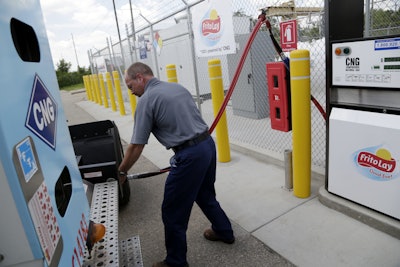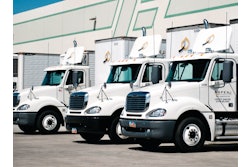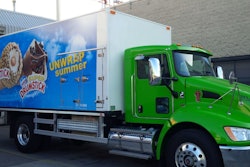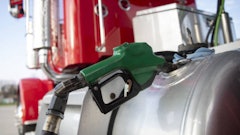
With general concerns over energy security and the thought of stronger emissions regulations from the Obama Administration on the way, it’s no surprise that fleet professionals across the food and beverage sector are focusing on alternative fuel vehicles (AFVs).
Even though the price of diesel fuel is still over a full dollar cheaper now than it was in May of 2014, it’s noteworthy that the price has gone up for six straight weeks. Most thought leaders involved in transportation are likely convinced the current low prices are only temporary.
In addition to the benefits offered by some alternative fuels such as lower costs, smaller carbon footprints and reduced emissions, fleet operators have to consider the upfront costs, including the need to train drivers and maintenance technicians about new technologies. Fleet managers also have to consider the available fueling infrastructure, tax credits and incentives, all of which can vary significantly among geographic regions.
Customer request ‘fuels’ interest in biodiesel
An early adaptor of alternative fuel vehicles was States Logistics Services, Inc., a third-party logistics solutions provider based out in Buena Park, Calif. States Logistics runs its entire California fleet using B99 biodiesel fuel, a blend of 1 percent diesel with 99 percent biodiesel that can be used in compression-ignition (diesel) engines with little to no modifications. But the switch for States Logistics didn’t happen because they wanted to lower their footprint, reduce emissions or lower their fleet costs … it was sparked by a much easier explanation.
“One of our customers asked if we were using biodiesel trucks, then asked if we’d be interesting in using it if we were not,” says Dale Fietsam, business development manager at States Logistics. According to Fietsom, the switch has proven to be a competitive advantage for States Logistics.
“The Port of Los Angeles and the Port of Long Beach don’t charge a ‘clean truck’ fee anymore, but trucks still have to meet certain emission requirements in order to pick up containers at those ports,” says Fietsam. “By using the biofuel, we meet those requirements easily. It’s really a benefit for our customers, and we’ve had potential customers come to us because they see the benefits the biofuels provide and they want to use a carrier that can provide that service.”
AFVs for ‘urban’ deliveries
Back in late 2014, Nestlé Waters North America put five medium-duty trucks fueled by propane autogas into service at its Los Angeles location delivering Arrowhead® Mountain Spring Water to area businesses and residents.
Among the reasons Nestle cited for the purchase of the propane trucks includes the fact they maintain full factory warranty, the ease of fueling, the low infrastructure cost and the unexpected benefit of lower electricity costs. Autogas infrastructure is less expensive to install than all other transportation fuels — conventional or alternative, with autogas costing up to 50 percent less than diesel on average.
“Nestlé Waters North America is committed to delivering customers drinking water with reliable, innovative and efficient green transportation solutions,” says Bill Ardis, fleet manager. “Like many, we are evaluating the different technologies that offer savings over the life of the vehicle and realized that propane autogas is a smart choice for reducing fuel and maintenance costs while providing cleaner air for the community.”
Partnerships help to build CNG infrastructure
While electric, propane and hybrid AFVs are still considered the “green” vehicles of choice for high-density, intra-city routes, the alternative fuel choice for most medium/heavy-duty fleets has become compressed natural gas (CNG). More CNG fueling stations have popped up to support the growth in CNG, both private and public. But costs are still relatively high, which means the most successful ventures are often shared among a team of partners.
On the day Frito Lay Inc. unveiled a brand new CNG fueling station in Beloit, Wis., they also announced plans to break ground on seven more public fueling stations across the U.S. with the goal of turning 20 percent of their delivery fleet to CNG vehicles. In order to get partners Questar Fueling, based in Salt Lake City, Utah, and Trillium CNG from Chicago, Ill., to invest in the venture with them, Frito Lay guaranteed to purchase a base volume of the gas to help the vendors justify building the infrastructure.
On Earth Day, Penske had a ribbon-cutting ceremony in Pottsville, Pa., at the grand opening of a new Trillium CNG fueling station that involved the collective efforts of Rochester, N.Y.-based Wegman’s Food Markets, Cherry Hill, N.J.-based supply-chain solutions provider NFI and consultants Gladstein, Neandross and Associates (GNA) out of Santa Monica, Calif. Drew Cullen, Penske senior vice president, called the station opening “an excellent example of how several organizations can work together and create a success story for the transportation industry to transition to alternative fuels.”
As the CNG infrastructure continues to grow, companies that are leading the way are having an easier time finding partners to support the investment.
“There are still challenges to implementing these tractors, and we will continue to test and implement this fuel wherever possible. But as the natural gas infrastructure grows, we will expand our footprint and introduce these power units in other areas of the country,” says Ron Hall, vice president of equipment and fuel at C.R. England, a Salt Lake City, Utah-based transportation solutions provider.
“We invest in advanced fuels, associated infrastructure, and advanced fuel vehicles to diversify our fuel sources … with a current emphasis on natural gas,” says Nanci Tellam, group director, environmental services at Ryder System, Inc., headquartered in Miami, Fla.
Ryder’s investment has been a big one, too. They have already rolled out natural gas transportation solutions in Arizona, Texas, California, New York, Utah, Georgia and Michigan. But they wouldn’t be doing it without the help of public and private industry partnerships.
Ryder’s $38.7 million SANBAG Project, a partnership between the U.S. Department of Energy, the California Energy Commission, and the Southern California Association of Governments Clean Cities Coalition, has Ryder deploying 202 heavy-duty, natural-gas-powered trucks across three Southern California locations. The project includes upgrading three maintenance facilities to service natural gas vehicles and constructing two publicly-accessible natural gas fueling stations.
When fully implemented, the project is expected to displace an estimated 1.5 million gallons of diesel fuel with 100-percent domestically produced natural gas.
No matter if it’s an electric, CNG, a hybrid or even an advanced alternative fuel that drives more fleets away from traditional diesel transportation, AFVs will continue to make a larger impact on how we transport the global food supply to all corners of our globe.
Hybrids, Nitrogen Engines And AFV Technology
The trends from 2014 and emerging ideas for 2015 and beyond.
Even though natural gas and propane have gained a larger share of the initial alternative fuel vehicles (AFV) market, they are by no means the only options making noise in the marketplace. As AFV technology continues to make substantial progress, options like hybrid engines and dual-fuel engines are gaining in popularity.
The U.S. Department of Energy continues to offer grant money to companies willing to invest in developing AFV technologies, and the investment is starting to produce options like liquid nitrogen engines and other innovations that will help to transform how food and beverage companies transport goods and materials.
Coca-Cola operates the largest heavy-duty hybrid electric delivery fleet in North America. The company is partnering with Boston, Mass-based XL Hybrids to upfit all new vans with the innovative XL3 hybrid electric drive system.
XL Hybrids pioneering electric powertrain technology is charge sustaining, which eliminates the need for plugs, return-to-base fueling, and added operating and maintenance costs. The hybrid system saves fuel through regenerative braking, a process by which the electric motor helps slow the vehicle when the driver brakes, charging the battery. When the driver accelerates, the battery releases the energy to the electric motor, helping propel the vehicle.
After converting 175 service vans to hybrids and driving more than 1.5 million service miles, vehicles with the XL3 hybrid electric drive system showed an approximate 20 percent reduction in gallons of fuel used compared to Coca-Cola’s conventional vans. Based on brake maintenance savings, engine downsizing, fuel savings and driver productivity, Coca-Cola estimates they are saving $15,000 to $20,000 per van in operational savings per year.
Dearman, a global technology company based in London, recently announced they will begin trials of a new engine later this year that uses liquid nitrogen to not only keep the reefer units cold, but power the vehicle as well. According to Dearman, it’s the first “system” developed so far using nitrogen gas to power and cool simultaneously.
Penske also just recently announced that they have been awarded a $400,000 grant from the U.S. Department of Energy to expand its Alternative Fuel Vehicle Demonstration and Enhanced Driver Experience Project, to educate and further introduce AFV innovations to customers currently not utilizing the technology.
“This is a unique program and the first of its kind for our company,” says Matt Krasney, Penske director of alternative fuels. “This grant allows fleets to experience AFVs at a reduced cost, and it will provide Penske the ability to expand our work with customer fleets via comprehensive demonstrations and deep dive technical support.”
Does Switching From Diesel to Natural Gas Really Reduce The Greenhouse Impact?
According to a recent study, unless the leaks in the natural gas supply chain are fixed, the climate effects get worse, not better.
As more food and beverage manufacturers, shippers, fleet operators and policy makers make the switch from diesel to CNG and other alternative fuels, many will justify the higher cost and reduced fuel efficiency of a natural gas truck for the advantage in reduced carbon dioxide emissions.
But a new study coauthored by researchers from New York-based Environmental Defense Fund (EDF) and published in the journal Environmental Science & Technology claims that shifting from diesel fuel to natural gas to power the nation’s heavy duty commercial trucking sector would not necessarily achieve its intended goals. The shift would only achieve the widely-promised climate benefits if widespread emissions of heat-trapping methane across the natural gas value chain are reduced.
The challenge is that methane – the main ingredient in natural gas – has 84 times the warming power of CO2 over a 20-year timeframe. Methane is released to the atmosphere at every step from production wells to the vehicle fuel tanks.
Otherwise, the study concludes that a conversion from diesel could lead to greater warming for the next 50 to 90 years before providing climate benefit.
“Natural gas trucks have the potential to reduce overall climate impacts compared to diesel, but only if we clean up the highly-potent greenhouse gas emissions from the systems that produce and deliver the fuel,” says Jonathan Camuzeaux, a study author and senior economic analyst at EDF. “Otherwise, the net warming effect is actually a negative one for 50 to 90 years after the fuel is burned.”
Approximately 6.3 million metric tons of methane escaped from the natural gas value chain in 2013, according to the Environmental Protection Agency’s latest Greenhouse Gas Inventory Report, producing the same 20-year climate impact as about 111 million cars or 140 coal-fired plants. This wasted gas is worth more than $1.42 billion, and is enough to meet the annual needs of about 5 million homes.
“The time to get ahead of this question is now, before this industry hits a major growth spurt,” says Jason Mathers, a commercial transportation expert working closely with shippers and truck makers in EDF’s Corporate Partnerships Program. “Reducing methane leaks upstream of the vehicles themselves will determine whether a shift in fuels will have a cost or a benefit for the climate.”
Natural gas vehicles currently use just 0.1 percent of the natural gas consumed in the U.S., but that number is expected to rise significantly as demand for heavy-duty natural gas vehicles grows. A recent study by the technology consulting firm ICF International found that the oil and gas industry could cut methane emissions 40 percent or more for about one penny per thousand cubic feet of natural gas produced – about one-third of one percent at today’s prices – by replacing emissions-prone valves and properly maintaining pumps and other devices.
“Policymakers who want to address climate change should use caution before promoting a switch to natural gas in the trucking sector until we are more certain about the magnitude of methane loss and have acted sufficiently to reduce emissions and improve natural gas engine efficiency,” Mathers says.
For More Information:
C.R. England, 800-453-8826, www.crengland.com
Dearman, +44 (0) 203-617-9170, www.dearmanengine.com
Environmental Defense Fund, 800-684-3322, www.edf.org
Penske, 888-236-3560, www.gopenske.com
Ryder System, Inc., 800-793-3765, www.ryder.com
States Logistics Services, Inc., 714-521-6520, www.stateslogistics.com
U.S. Department of Energy, 202-586-5000, www.energy.gov
XL Hybrids, 617-718-0329, www.xlhybrids.com















